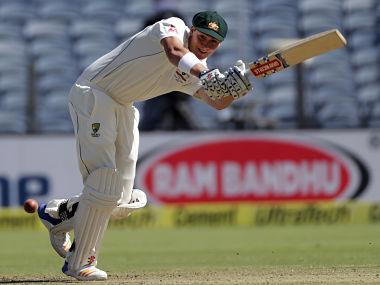Matt Renshaw, all of 20 years of age and the toast of Australia, is a veritable thorn in the flesh of this Indian cricket team. The left-hand batsman’s single-minded stonewalling of spinners, Ravichandran Ashwin and Ravindra Jadeja has got to the point that the very sight of him would get their spinning fingers weary!
His knocks of 68 and 31 in Pune and the stubborn 60 from over four and a half hours of batting spread over two days in Bengaluru have been nothing short of monumental. He has looked at such ridiculous ease against the spinners that it has been both unnerving and awe-inspiring at once. So how did he get to be so good against world class spinners and that too at such a young age?
On the eve of the Bengaluru Test I took the Renshaws — Matt, his girlfriend Jose and parents Ian and Alison — to a local club in the heart of the city and during the course of an evening talking cricket, his father, a doctorate in cricket research and senior lecturer at Queensland University of Technology, revealed the coaching drills that made Matt understand the ways of spin at a very tender age.
“He was just two years of age when I used to under-arm slow spin throws with a basketball. He had to catch it. He caught on to the direction of spin imparted very quickly and started moving in the right direction and catching them clean,” said Ian Renshaw.
Both his parents were PE teachers in England, where Matt was born. They later shifted to Auckland when Ian’s work took them there. After seven years in New Zealand they moved to Brisbane, Australia when Matt was just 10 years of age.
All the while his father, who also coached football and rugby, took care to groom his son’s cricketing talent while the mother stuck to teaching PE and later mathematics to secondary school students.
“I played cricket for Nottingham. So I guess I understood what needed to be done to get Matt up to speed. He didn’t get into age group tournaments as soon as we went to Australia. But the very next year he was in the under-12 side and progressed rapidly from there,” Ian said.
Interestingly, in an article last year ( http://cricwizz.com/blog/2016/04/26/t20-no-ball-conundrum-visual-cues-hold-key/ ) I had quoted a research paper by a team of Australian and UK researchers in the European Journal of Sports Science which stated that bowlers at nets used the stumps as a visual reference to make adjustments as they approached the delivery stride. But in a match the physical presence of an umpire subconsciously altered the reference points and forced critical changes to a bowler’s run-up to the delivery stride and this could trigger no-balls at inopportune times.
Ian pointed out that it was his research which had argued that vertical objects helped gauge distance when moving towards something and gave examples of driving towards a traffic light or walking towards a door and said that these vertical objects served a ‘looming’ effect to gauge distance. Speed or stride was adjusted based on cues from these vertical objects.
Matt, who hopes to someday be a sports journalist and has done a bit of television commentary of junior cricket, revealed that he had trained extremely hard at batting before embarking on the India tour. The focus, he said, was on playing close to the pad and in not chasing the spinning ball. Patience at the crease, he pointed out, came naturally to him. “When I was young I was the smallest in our group. So when I batted I had to quit only when I reached 50 runs and not when I got out. I loved to bat. Therefore I would score my runs as slowly as possible so that I could get maximum batting time before reaching 50.
“My approach in the Pune Test was much the same. I simply stayed put at the wicket and absorbed everything that the bowlers threw at me.”
Matt revealed that he was earlier part of an MCC scholarship to Lord’s and was on the ground staff when Sachin Tendulkar came to play in an MCC exhibition match. “He brought his own set of bowlers to the nets. He would not bat against anyone else. One of our guys, who was of Indian origin, pleaded with him to give him the pleasure of bowling a few deliveries to him. He finally agreed and then simply swatted away three or four deliveries.
“What I noticed was the intensity with which he practiced and the strict routine he went through. I recalled this after the issues I had with the stomach bug in Pune. I’ve been a lot more circumspect since then,” he said.
That was evident in the fact that while his girlfriend Jose, a law student, and his parents were comfortable with the curry foods available at the club, Matt was wary and skipped almost everything.
Considering that the Indian team tried to get under his skin at the M Chinnaswamy Stadium and kept ribbing him that if he needed to use the washroom during his marathon innings, it was the right call after all.
At just 20 years of age, Matt seems to be batting with a drive and focus that belie his young age. This hard tour of India at a very impressionable age would do wonders for his long-term development as a world-class batsman. And when that happens, the Renshaws would have found their journey from the comforts of their country of birth to Australia via New Zealand would have been worth every single kilometre travelled.


)




)
)
)
)
)
)
)
)